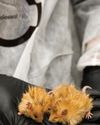What's Behind Your Eyes
January 2022
|Muse Science Magazine for Kids
The Science of Sight

Our eyes act like a camera. They capture images from the world around us. The images can be individual objects or the features of the setting we are located in. Our eyes also help us to identify the vivid color of an object-a rose or an apple, for instance—from the surrounding background. Looking at the rose, we can guess how far it is from us. Our eyes can also discern the texture and other features of the flower. We do all this automatically, without thinking about it.
More Than a Camera
But a neuroscientist will explain that a human eye is more than a camera. It not only captures images but also transmits and interprets these images. An eye is a complicated organ with a deceptively simple structure. Some organisms possess light-sensitive cells clustered together, known as “simple eyes.” Such eyes can distinguish light and dark, but they can't detect objects or images. Even simple eyes, however, require an extremely complex mechanism to support vision.
Behind the Scenes
The process of vision begins when photons are first sensed by a specialized molecule in the eyes called 11-cis-retinal. Just as ice changes when exposed to heat, the molecule that chat captures the photon also changes ss shape and structure. This new molecule is called a rhodopsin. The energy of the photon continues to change the shape and structure of the rhodopsin into a new molecule. The new shape and structure is called metarhodopsin II. This shape is a perfect fit, like a piece in a jigsaw puzzle, for a gap in a giant protein.
هذه القصة من طبعة January 2022 من Muse Science Magazine for Kids.
اشترك في Magzter GOLD للوصول إلى آلاف القصص المتميزة المنسقة، وأكثر من 9000 مجلة وصحيفة.
هل أنت مشترك بالفعل؟ تسجيل الدخول
المزيد من القصص من Muse Science Magazine for Kids

Muse Science Magazine for Kids
ANIMAL FIREFIGHTER TO THE RESCUE
Can animals help manage the risks of deadly wildfires?
3 mins
Muse July 2025: The Story Behind Wildfires

Muse Science Magazine for Kids
FIRE DANGER
WHY THE RISK OF WILDFIRES KEEPS GROWING
4 mins
Muse July 2025: The Story Behind Wildfires

Muse Science Magazine for Kids
The Miller NEW Normal
WHAT TODAY’S WILDFIRES TELL US ABOUT OUR FUTURE
8 mins
Muse July 2025: The Story Behind Wildfires

Muse Science Magazine for Kids
WOMEN AND FIREFIGHTING: A GOOD FIT
Jessica Gardetto is a firefighter. Her father was, too. “I grew up with my dad coming home smelling like wildfire and covered in soot,” she says.
1 min
Muse July 2025: The Story Behind Wildfires

Muse Science Magazine for Kids
What is happening on your fingertips when they get all wrinkly in a hot tub?
—Felix G., age 10, Montana
1 mins
Muse July 2025: The Story Behind Wildfires

Muse Science Magazine for Kids
WHEN the SMOKE CLEARS
THE LINGERING EFFECTS OF THE RECENT PACIFIC PALISADES AND ALTADENA EATON FIRES
6 mins
Muse July 2025: The Story Behind Wildfires

Muse Science Magazine for Kids
PICKING TEAMS
Keep it fair with a strategy that relies on geometry.
2 mins
Muse July 2025: The Story Behind Wildfires

Muse Science Magazine for Kids
SHAN CAMMACK
WILDLIFE BIOLOGIST AND FIRE SAFETY OFFICER
3 mins
Muse July 2025: The Story Behind Wildfires

Muse Science Magazine for Kids
Scientists Create Mice With Woolly Mammoth-Like Fur
RESEARCHERS AT A COMPANY IN TEXAS ARE WORKING TO CREATE A LIVING ANIMAL THAT RESEMBLES THE EXTINCT WOOLLY MAMMOTH. Recently, they produced mice with traits of the large mammal. The mice all have coats with mammoth-like fur, and some of the small mammals also have genes that help them store fat. Both features would help the animals survive in the cold Arctic, where the woolly mammoth once lived.
1 min
Muse July 2025: The Story Behind Wildfires

Muse Science Magazine for Kids
Cool Sunshade Added to the Nancy Roman Space Telescope
THE NANCY ROMAN SPACE TELESCOPE IS A NEW TELESCOPE THAT NASA IS BUILDING AND WILL LAUNCH INTO SPACE, LIKELY IN EARLY 2027.
1 min
Muse July 2025: The Story Behind Wildfires
Translate
Change font size
